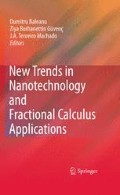Abstract
The fractional wavelet transform (FWT) combined with zero crossing technique was applied to the absorption spectra for the quantitative resolution of a binary mixture consisting of trimethoprim and sulfachloropyridazine sodium. The absorption spectra of trimethoprim and sulfachloropyridazine sodium were processed by FWT method. In the following step, the FWT spectra were obtained by plotting the fractional wavelet coefficients versus the wavelength. Classical second derivative method was applied to the fractional wavelet signals in the wavelet domain. A calibration graphs for each substance were obtained by measuring the FWT-amplitudes at an appropriate wavelength corresponding to a zero crossing point in the derivative spectra of the FWT-signals. The amounts of trimethoprim and sulfachloropyridazine sodium in tablets.
Access this chapter
Tax calculation will be finalised at checkout
Purchases are for personal use only
References
Blu T, Unser M (2000) The fractional spline wavelet transform: definition and implementation. Proceedings of the Twenty-Fifth IEEE International Conference on Acoustics, Speech, and Signal Processing (ICASSP’00). Istanbul, Turkey, 5–9 June, vol. I, pp 512–515
Blu T, Unser M (2002) Wavelets, fractals, and radial basis functions. IEEE Trans Signal Process 50(3):543–553
Unser M, Blu T (1999) Construction of fractional spline wavelet bases. In: proc.SPIE Wavelets Applications in Signal and Image Processing VII, Denver, CO, 3813, pp 422–431
Unser M, Blu T (2000) Fractional splines and wavelets. SIAM Rev 42(1):43–67
Miller KS, Ross B (1993) An introduction to the fractional integrals and derivatives-theory and applications. Gordon and Breach, Longhorne, PA
Oldham KB, Spanier J (1974) The fractional calculus. Academic, New York
Podlubny I (1999) Fractional differential equations. Academic, San Diego
Daubechies I (1992) Ten lectures on wavelets. Society for Industrial and Applied Mathematics, Philadelphia, 1992
Walczak B (2000) Wavelets in chemistry. Elsevier, Amsterdam, The Netherlands
Dinç E, Baleanu D (2004) Multicomponent quantitative resolution of binary mixtures by using continuous wavelet transform. J AOAC Int 87(2):360–365
Dinç E, Baleanu D (2006) A new fractional wavelet approach for simultaneous determination of sodium and sulbactam sodium in a binary mixture. Spectr Acta Part 63(3):631–638
Dinç E, Baleanu D (2004) Application of the wavelet method for the simultaneous quantitative determination of benazepril and hydrochlorothiazide in their mixtures. J AOAC Int 87(4): 834–841
Dinç E, Baleanu D (2007) A review on the wavelet transform applications in analytical chemistry. In: Tas K, Tenreiro Machado JA, Baleanu D (eds) Mathematical Methods in Engineering. Springer, pp 265–285
Dinç E, Baleanu D, Üstündağ Ö (2003) An approach to quantitative two-component analysis of a mixture containing hydrochlorothiazide and spironolactone in tablets by one-dimensional continuous Daubechies and biorthogonal wavelet analysis of UV-spectra. Spectr Lett 36: 341–355
Author information
Authors and Affiliations
Corresponding author
Editor information
Editors and Affiliations
Rights and permissions
Copyright information
© 2010 Springer Science+Business Media B.V.
About this chapter
Cite this chapter
Kanbur, M., Narin, I., Özdemir, E., Dinç, E., Baleanu, D. (2010). Fractional Wavelet Transform for the Quantitative Spectral Analysis of Two-Component System. In: Baleanu, D., Guvenc, Z., Machado, J. (eds) New Trends in Nanotechnology and Fractional Calculus Applications. Springer, Dordrecht. https://doi.org/10.1007/978-90-481-3293-5_28
Download citation
DOI: https://doi.org/10.1007/978-90-481-3293-5_28
Published:
Publisher Name: Springer, Dordrecht
Print ISBN: 978-90-481-3292-8
Online ISBN: 978-90-481-3293-5
eBook Packages: EngineeringEngineering (R0)

